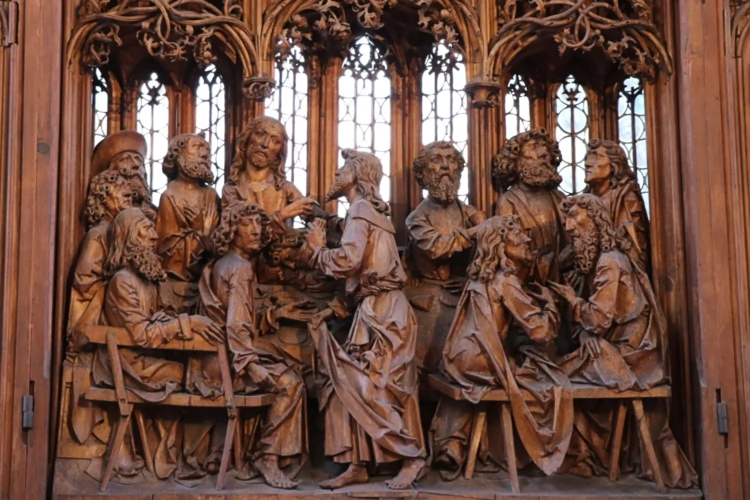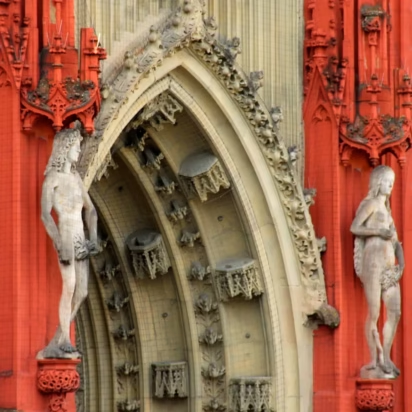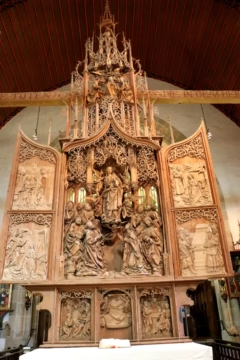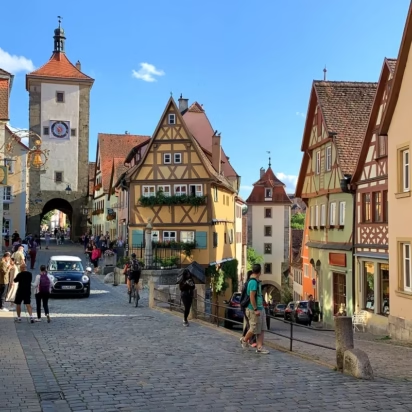The Virgin Mary Altar (Marienaltar) by Tilman Riemenschneider in the Herrgottskirche in Creglingen is a popular stop on the Romantic Road in Germany.

The small Gothic Herrgottskirche in Creglingen near Würzburg and Rothenburg ob der Tauber is a medieval artistic highlight when traveling along the Romantic Road (Romantische Straße) in Germany. This Lord’s Chapel has four altars, including the Altar of the Virgin Mary (Marienaltar) — a masterpiece by the Late Gothic sculptor and woodcarver Tilman Riemenschneider. It is one of the most important medieval wood-carved artworks in Germany and as much worth seeing for its exquisitely carved details as for the religious messages in the work.
Gothic Herrgottskirche and Altar in Creglingen
On the outskirts of the small town Creglingen, population 4700, are two of the best-known sights on Germany’s Romantic Road (Romantische Straße): the Herrgottskirche with a Riemenschneider Altar and the Thimble Museum.
The monumental Marienalter (Altar of the Virgin or Mary’s Altar) by Tilman Riemenschneider in the Herrgottskirche (Lord’s Chapel) in Creglingen is a seminal work of art appreciated by thousands of annual visitors from all over the world.
As with so many other wonderful chapels in Bavaria, the origins of the Herrgottskirche are simple. In 1384, a farmer plowing his fields found a “hostie” (host, or communion bread wafer) in perfect condition. This was considered a miracle and the local ruling family, Hohenlohe-Brauneck, built a Gothic chapel that soon was declared a pilgrimage site (Wallfahrtsort).
Already in 1404, it received papal permission to sell indulgences. Pilgrims arrived in droves and money flowed in.
In 1448, the Margrave of Brandenburg-Ansbach bought all the land of the Brauneck family. Prosperity continued — all the altars in the church date from the decades after this acquisition.
However, in 1530, Ansbach introduced the Reformation and the chapel became Protestant.
For the Herrgottskirche, income from pilgrimages came to an abrupt end. The Marienaltar was covered up and the magnificent carving only rediscovered three centuries later in 1832.
(German political geography and history are complicated but this also partly explains why Creglingen, although Franconian, is in the modern federal state of Baden-Württemberg and not in Bavaria like nearby Rothenburg.)
Today, the Herrgottskirche and Riemenschneider altar are once again very popular destinations. It is a stop on the Romantic Road and on the Taubertal cycling route.
Riemenschneider Marienaltar in Creglingen
The Virgin Mary’s Retable (Marienaltar) is not only the largest of the four altars in the Herrgottskirche, but it is also artistically by far the most accomplished. It measures an impressive 9.2 m high, 3.68 m wide, and 0.44 m deep (30 x 12 x 1.4 ft). The mainframe and structural elements are from pine (Föhren), while the figures and detailing are carved from softer lime wood (Linden).
The master woodcarver Tilman Riemenschneider (1460-1531) sculpted the Altar of the Virgin probably between 1505-10 — slightly later than the magnificent Holy Blood Altar in nearby Rothenburg ob der Tauber. It is one of his masterpieces, not so much for its monumental size as for the exquisite details in the faces and clothes of the characters.
In creating this High Gothic altar for the Herrgottskirche in Creglingen, Riemenschneider followed the customary triptych layout for the period: the main shrine (Mittelschrein), which is based on a predella, may be closed by two side wings (Seitenflügel), while the whole altar is topped by an intricately carved superstructure (Gesprenge).
Predella of the Marienaltar

The predella of the Altar of the Virgin in the Herrgottskirche in Creglingen consists of three equal-sized niches:
- The niche in the center has an empty space that explains the existence of this altar, and indeed the whole church. The niche originally hosted the monstrance with the relic of the hostie (wafer), which is now lost, and remains empty.
- The scene in the left niche is the ever-popular adoration of the magi — the three wise men present Mary with gifts. She is the focus of this altar, not Christ, who isn’t present in this scene.
- The right niche is the apocryphal story of a five-year-old Jesus speaking from the benches like an adult, although the biblical story of the 12-year-old Christ preaching in the temple could also work. Once again, Mary is prominent in the foreground while Christ is somewhat in the shadows in the back. However, the more interesting figure here is the one in the middle right — it is generally considered to be a self-portrait of Riemenschneider.
Assumption of Mary in the Central Altar
The main theme of this altar is depicted in the central scene: the Assumption of Mary (Marias Himmelfahrt). According to Roman Catholic and a few other Christian traditions, Mary, mother of Christ, ascended to heaven after her death. As there are no clear references to this in the standard bible, Protestants generally reject this notion. Depictions of the Ascension of Mary were often destroyed by iconoclasts during the Reformation.
Mary ascends to heaven in the presence of the twelve apostles. All are portrayed as life-sized statues with different facial expressions, elaborate beards, and flowing drapery. In the empty space between the apostles and Mary, an angel flies to convey the impression of distance and to emphasize that Mary is ascending. This effect is particularly strong when looking up at the altar when on your knees right in front of it.
Mary, with typical folded hands, is accompanied by angels to heaven. The intricately carved High Gothic intertwining vines (Rankengeflecht) symbolize the gateway to heaven and show off Riemenschneider’s talent. This delicate latticework and the story continue higher up.
Coronation of the Virgin Mary
The scene in the superstructure of the Mairenalatar is the crowning of the Virgin Mary. This coronation event is also apocryphal and not accepted by most non-Roman-Catholic Christians.
Angels lower the crown of heaven onto Mary in the presence of God the Father and God the Son. God the Holy Spirit flies higher in the form of a dove above the statue of Christ Man of Sorrows at the top of the altar.
Wings of the Altar of the Virgin in the Herrgottskirche in Creglingen

The four low relief carvings on the side wings of the Mary altar are clockwise from bottom left:
- Annunciation — the archangel Gabriel informs Mary that she is pregnant with the son of God.
- Visitation — Mary visits her cousin Elizabeth, who is pregnant with the later John the Baptist.
- Nativity — Jesus is carved remarkably small; often the baby is oversized in these works (compared with the high altar).
- Presentation — Jesus is presented in the temple. Note the dove in Josef’s hand — not the holy spirit but rather the offering of the poor.
Winged altars could be opened and closed according to the church calendar to reveal or hide the scenes. The outside of the wings, like the back of the complete altar, is basically bare and without any adornments.
This helped save the altar when this part of Franconia became protestant. The altar was simply closed and for centuries, covered with other decorations.
Riemenschneider’s masterpiece was only again revealed three centuries later when opened in 1832.
The altar is positioned so that sunlight lit up the ascension of Mary during the final two weeks of August.
August 15 is traditionally the date of Mary’s Assumption, but calendar reform shifted the best day for this liturgical light spectacle two weeks back.
This light is best seen late afternoon after 17:00, which explains the longer opening hours in the final two weeks of August.
Who Was Tilman Riemenschneider?
Tilman Riemenschneider (c. 1460 – 1531) was a German sculptor and woodcarver working mostly in the Würzburg region (Northern Bavaria in modern political geography). He worked in both stone and wood but his lime-wood carvings, especially exquisite large unpainted altarpieces, are his best works. Written records on his life are rare and nonexistent on his thoughts or feelings.
Riemenschneider came from a relatively modest background but worked himself up (and married well, four times) to owning a workshop with 40 employees, several properties including his own wine farm, and a seat on the town council. His downfall was his misfortune to be mayor of Würzburg and a senior town councilor during the Peasant Revolt. He supported the peasants against the ruling prince bishop in 1525 and once the bishop restored order, Riemenschneider was imprisoned for a few months and lost much of his wealth. He produced no known new works during the final six years of his life leading to speculation that his hands were broken under torture.
Riemenschneider Revival
Following his death, Riemenschneider was soon forgotten. He was out of political favor and taste in art changed. In contrast to his contemporaries in the Free Imperial City of Nuremberg — such as Albrecht Dürer and Veit Stoß — he would only achieve fame long after his death. A chance discovery of his grave near Würzburg Cathedral in 1822 led to renewed interest and appreciation of his skill.
Neil MacGregor, former director of the National Gallery and British Museum, considered the intensity and subtlety with which Riemenschneider exposed the spiritual comparable to Donatello.
Julian Chapuis, director of the Bode Museum in Berlin, considered his ability unsurpassed in the control of the chisel to create expressions in a woodcarving that will remain unpainted.
Riemenschneider is never theatrical. His art does not shout. It articulates convincingly and softly. We recognize our hopes, our weaknesses, our aspirations … His talent resides in making God approachable on a personal level and in that sense he is, if you want, a Reformation artist, even though he worked for the Catholic Church all his life.”
Chapuis: Quoted in Germany — Memories of a Nation by Neil MacGregor (quite an interesting read.)
See Riemenschneider Art in Germany
Some of Tilman Riemenschneider’s works include:
- Altar of the Virgin in the Herrgottskirche in Creglingen
- Altar of the Holy Blood in the St.-Jakobs-Kirche in Rothenburg ob der Tauber
- Altar of Mary Magdalene — copy in Münnerstadt but the original is now split up and pieces spread over several museums including the Bode Museum in Berlin.
- Sculpture of Bishop Rudolf von Scherenberg in Würzburg Cathedral
- Emperor’s Tomb in Bamberg Cathedral
- A few works in Würth Collection and Johanniterkirche in Schwäbisch Hall.
- A sandstone Virgin Mary in the Liebieghaus Museum in Frankfurt.
- Adam and Eve – copies outside the Marienkapelle in Würzburg. The originals and
- More than 80 works are in the Mainfränkischen Museum in the Marienberg Fortress in Würzburg.
- St Elizabeth and Lamentation of Christ in the Germanisches Nationalmuseum in Nuremberg (Nürnberg).
Other Altars in the Herrgottskirche in Creglingen

The Riemenschneider altar is by far the best artistic work in the Herrgottskirche but the other altars and some furnishing are interesting to see too. The other altars are slightly older and followed the more popular tradition of painting the statues.
Right Altar — John the Evangelist and St Lucia
The carver of the late 15th-century altar in the Nuremberg style on the right is unknown but it was painted by Jakob Mühlholtzer. It is dedicated to John the Evangelist and St Lucia. They and St Ottilia, St Afra, and St Agatha of Catania are presented as colorfully painted carved figures in the central shrine. The painting on the outside of the wings is of the Annunciation.
The predella is all about bread. Left Melchizedek brings wine and bread to the armored Abraham while on the right manna rains from heaven in the shape of the hosts (wafers).
At the center is a wood-carved Last Supper — not quite to the same standard as Riemenschneider’s disciples.
The altar is topped by Christ as Man of Sorrows, flanked by two angels carrying instruments of his torture — a lance and a sponge on a stick.
High Altar in the Herrgottskirche in Creglingen
The main high altar (Hochaltar) in the choir is a late 15th-century work by unknown artists — some would like to think of it as by Veit Stoß or his followers.
At its center is a very expressive crucifixion scene, which in no way attempts to sterilize the cruelty of the event. On the side panels are on the left, Jesus in the Garden of Gethsemane and the way to Golgotha, and on the right, the entombment and the resurrection.
As with the Marienaltar, the high altar is topped by Christ as Man of Sorrows, flanked by two angels with the instruments of torture.
The three carved figures on the predella are from left: St Christopher carrying Christ, St Anna embracing Mary and a very large baby Jesus, and St Andreas.
Left Altar — John the Baptist and St Leonard
The altar on the left of the choir is dated to around 1460 and attributed to Dutch carvers. However, it was mostly painted by Jakob Mühlholzer, who dated it as 1496 on the front.
This altar is dedicated to John the Baptist and St Leonard, who are portrayed in the predella with the holy deacon. Mark the Evangelist is painted left and Matthew right. The scenes at the center are the wedding of Mary, the birth of Christ, and the adoration of the magi. The presentation in the temple is painted on the right wing.
The altar is topped by St Sebastian, flanked by an archer and a crossbow shot.
Further Sights in the Herrgottskirche in Creglingen
Much of the stained and painted glass windows in the Herrgottskirche are original. Some show the shield of the Hohenlohe-Brauneck family that ruled the area at the foundation of the church, e.g., above Maria in the windows of the nave.
The 15th-century choir stalls have the emblem of Ansbach, which was in control at the time of the Reformation.
The large St Christopher painting is from 1886 by an unknown artist. The (locked) door below this painting leads to the external Tetzel Chancel (Tetzelkanzel) — which is only visible from the outside of the church. According to tradition, the Dominican priest Johannes Tetzel, who got Martin Luther’s back seriously up, preached from here to promote the buying of indulgences.
Visitor Information: Herrgottskirche in Creglingen
The opening hours of the Herrgottskirche are as follows:
- April to October: Tuesday to Sunday from 11:00 to 17:00 (closing 18:30 the last two weeks of August)
- March, November & December: Saturday and Sunday from 13:00 to 16:00
The Herrgottskirche is closed on Mondays, all month January and February, and 24 & 25 December.
The church is closed for sightseeing during funeral services — most likely weekdays between 13:00 and 14:00. In such case, don’t rush the Thimble Museum, which is across the street from the church. (This small museum is currently only open by prior arrangement.) The only real other sights in Creglingen are the eccentric Lindleinturm Museum and a few pretty half-timbered houses but not to the same extent as other towns on the Romantic Road.
Admission is €4 for adults and €3.50 for children and students. A family ticket is €10.
The Herrgottskirche is in the outskirts of Creglingen, just off the main road, traveling in the direction of Rothenburg ob der Tauber. The signposting is very clear.
Arriving by car, bicycle (it is on the Taubertal cycling route), or on foot are the best options. If the Romantic Road bus runs, it usually stops here long enough to see either the Herrgottskirche or the Thimble Museum. See also other sights in the Liebliches Taubertal region for stops on the northern parts of the Romantic Road.
More on Rothenburg ob der Tauber
For more on the Rothenburg ob der Tauber and nearby sights on the Romantic Road:
- Top Sights on the Romantische Straße with Romantic Road Map
- Walk on the Ramparts and Sentry Walk on the Wall of Rothenburg
- Visit the St.-Jakobs-Kirche (St James Church) with the Tilman Riemenschneider Holy Blood Altar
- Visit the Medieval Crime Museum
- Visit the Wolfgang’s Church in the Klingenbastei
- See the Herrgottskirche with Tilman Riemenschneider Altar of the Virgin in nearby Creglingen
- Transportation to Rothenburg ob der Tauber – Driving or Take the Train
- Bus Day-Trip Tours are often available from Frankfurt or Munich.
- Hotel prices in Rothenburg are surprisingly reasonable, except over weekends.
- Save with the Bayern-Ticket on Train Transportation in Bavaria
- Get online quotations for taxis and airport shuttles from Frankfurt or Munich airports.

















